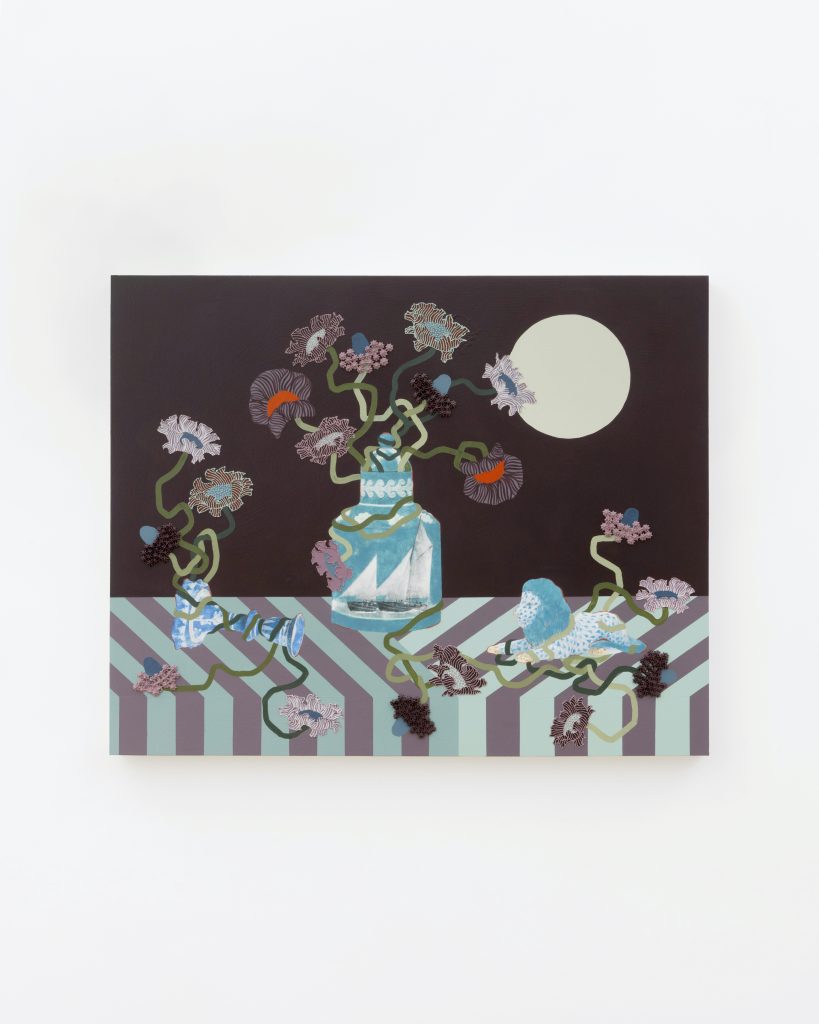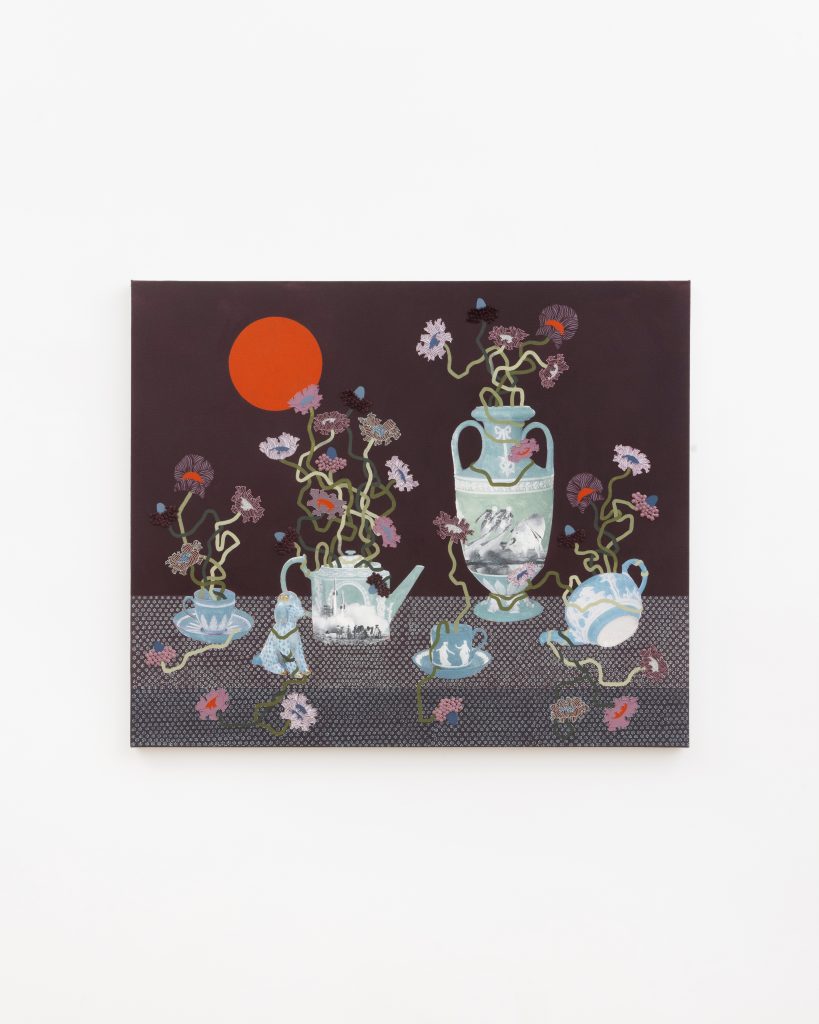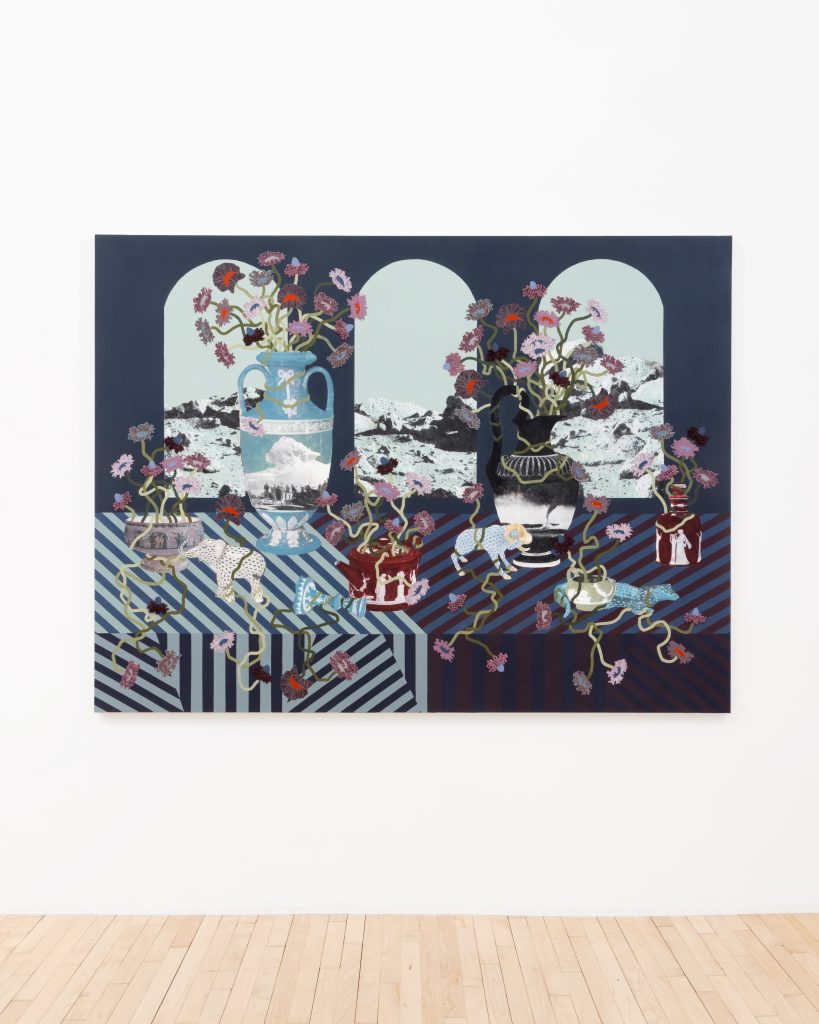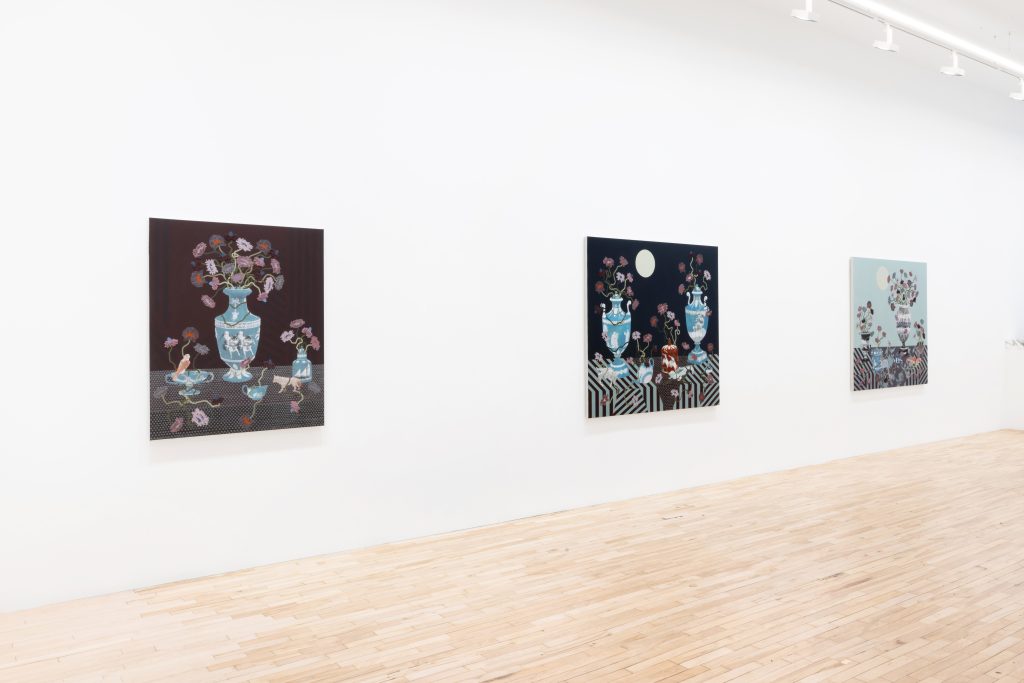I know they’re very straightforward, but I love still lifes in the fine arts.
When there’s generally no immediate action in the scene you’re looking at, and you’re instead left with something just… there and present in front of you, you’re pushed into pondering the many non-corporeal elements of anything being in any place: the relationship between the (generally inanimate) thing and whatever or whoever put it there, what relationships are forming between the object or thing and what’s around it, and what may be emanating from each individual part of the scene itself — which normally are things we might see a lot but actually stop and gaze upon much less often.
And in Lizzie Gill’s new exhibition at HESSE FLATOW in New York, which is full of still life paintings, artifice and ornamentation become a matter as much of the expanse behind them as they are of orderly spatial arrangement. The experiential horizon grows, exponentially.
Gill maintains enough aesthetic clarity in her exhibited artworks to establish each item depicted in these paintings as something at least artistically real and distinguishable, but they don’t approximate the full breadth of three-dimensional space, and don’t endeavor to. Yet, the painted images do repeatedly move backwards into a surprising horizon above which a celestial body of some sort sits — the inside, or at least what we usually know as the interior, directly melded with the outside.
And if there’s not an actual celestial body hanging above, what we see as the backgrounds of the surfaces holding the artistically realized objects still look like horizons — horizons that are somehow now right here in front of us, not at the distance that we’re used to. The next, and the other, and the beyond: they all feel within reach amid the sweeping, snaking artifice of Gill’s paintings: captivating flair that feels infused with the power and reach of determination, and the capacity to provide… maybe not an ending, but at least something to come next. In Gill’s artworks, we have the opportunity to really, truly see what we’re looking at; there’s an air of clarity — a presence of truth — amid the sprawling forms of what Gill painted.
The exhibition’s imagery itself — what’s spread across the surface depicted within each artwork — is captivating, with vases, pitchers, dishes, and flowers looping every which way. Besides acrylic, Gill also utilized an image transfer process — putting at least somewhat recognizable and cognizable, external images within her artistic offerings — and a marble dust emulsion, adding visual texture and activity, and amplifying the sense of the next to another level.
The transferred images are things like what’s clockable as the surface of the moon in “Lunar Still Life (Avec le Elephant)” (2025). The images that the artist sourced start in an internal logic different from the one we expect from painting and start to see within Gill’s paintings in particular, and the nearly sculptural texture sitting gently across Gill’s artistic surfaces feels much the same: something of sculpture and touch, even if we only sense it comparatively briefly across the surfaces of Gill’s paintings.
But here, they’re all together. The strictly delineated — the still life, which hearkens to our always very present experiences of the three-dimensional — becomes enmeshed with the promise of a horizon. There’s more behind and beyond these individual objects, a suggestion of and opportunity for something entirely new and refreshed. Those visual horizons hang consistently across Gill’s artworks: a reminder, a promise, and an invitation.
Everything we’re looking at within Gill’s paintings hangs with the same kind of gentle, sincere confidence, breadth, and unexplained, largely unelaborated wonder that points towards the horizons in the external, real world that we experience. If you imagine the formal, spatial feel of stars spreading across a night sky (if you’re in a place where they’re visible), that’s like what happens here.
The future and what it mirrors of the past are complements to the present in this art. The next and the beyond are surprisingly accessible — and with the consistency across Gill’s artworks with which she approaches the development of individual, scenic elements into the grand beyond, you end up feeling kind of pushed into it, even while remaining very much present with the actual substance of the objects in front of you that you’re looking at. But in them, there is already something of whatever will be coming next.
The relatively free-flowing aesthetic of Gill’s artistic constructions allows for and encourages the use of real space to make something of the assemblages we see in front of us, both inside of the art in our perceptions and outside of it. And it all hooks you in place in the meantime. Gill’s flowers look liable to grow somehow right off and out of the canvases and around your actual, physical spot in the world.
Lizzie Gill’s exhibition at HESSE FLATOW continues through April 26.



Featured image: Lizzie Gill: “Paraphernalia” (installation view), HESSE FLATOW, New York, March 21 – April 26, 2025. Courtesy of the artist and HESSE FLATOW, New York. Photo: Jenny Gorman
You may also like
-
Diana Kurz at Lincoln Glenn in New York: A Review of a Shining Art Exhibition
-
Dustin Hodges at 15 Orient in New York City: An Ensnaring Exhibition at an Exciting Gallery
-
Maren Hassinger at Susan Inglett Gallery in New York: Reviewing an Uplifting Art Exhibition
-
Enzo Shalom at Bortolami in New York City: Reviewing an Entrancing Exhibition of Paintings
-
“Ben Werther: Townworld” at Amanita in New York City: Reviewing a Richly Memorable Art Exhibition
